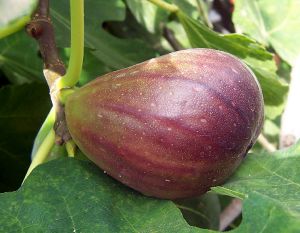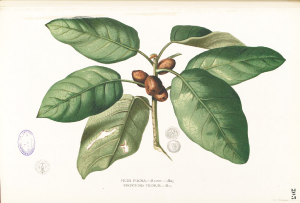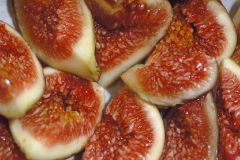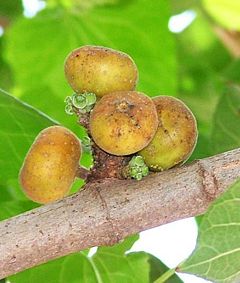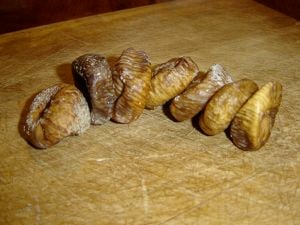Fig
| Ficus | ||||||||||||
|---|---|---|---|---|---|---|---|---|---|---|---|---|
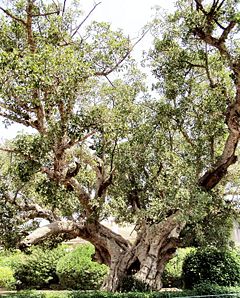 Ficus sycomorus
| ||||||||||||
| Scientific classification | ||||||||||||
| ||||||||||||
|
About 800, including: |
| Figs, fresh Nutritional value per 100 g | ||||||||
|---|---|---|---|---|---|---|---|---|
| Energy 70 kcal 310 kJ | ||||||||
| ||||||||
| Percentages are relative to US recommendations for adults. Source: USDA Nutrient database | ||||||||
| Figs, dried Nutritional value per 100 g | ||||||||
|---|---|---|---|---|---|---|---|---|
| Energy 250 kcal 1040 kJ | ||||||||
| ||||||||
| Percentages are relative to US recommendations for adults. Source: USDA Nutrient database | ||||||||
Ficus is a genus of about 800 species of woody trees, shrubs and vines in the family Moraceae, native throughout the tropics with a few species extending into the warm temperate zone. The most well known species in the genus is the Common Fig.
One species of this genus, the Common Fig (F. carica), produces a commercial fruit called a fig; the fruit of many other species are edible though not widely consumed. Other examples of figs include the banyans and the Sacred Fig (Peepul or Bo) tree. Most species are evergreen, while some from temperate areas, and areas with a long dry season, are deciduous.
Fruit and pollination
The fig is commonly thought of as fruit, but it is properly the flower of the fig tree. It is in fact a false fruit or multiple fruit, in which the flowers and seeds grow together to form a single mass.
The genus Dorstenia, also in the fig family (Moraceae), exhibits similar tiny flowers arranged on a receptacle but in this case the receptacle is a more or less flat, open surface.
A fig "fruit" is derived from a specially adapted type of inflorescence (structural arrangement of flowers). What is commonly called the "fruit" of a fig is actually a specialized structure- or accessory fruit- called a syconium: an involuted (nearly closed) receptacle with many small flowers arranged on the inner surface. Thus the actual flowers of the fig are unseen unless the fig is cut open. In Chinese the fig is called 'fruit without flower'. The syconium often has a bulbous shape with a small opening (the ostiole) at the distal end that allows access by pollinators. The flowers are pollinated by very small wasps that crawl through the opening in search of a suitable place to reproduce (lay eggs). Without this pollinator service fig trees cannot reproduce by seed. In turn, the flowers provide a safe haven and nourishment for the next generation of wasps. Technically, a fig fruit would be one of many mature, seed-bearing flowers found inside one fig.
Most figs come in two sexes: hermaphrodite (called caprifigs from goats - Caprinae subfamily; as in fit for eating by goats; sometimes called "inedible") and female (the male flower parts fail to develop; produces the "edible" fig). Fig wasps grow in caprifigs but not in the other because the female trees' female flower part is too long for the wasp to successfully lay her eggs in them. Nonetheless, the wasp pollinates the flower with pollen from the fig it grew up in, so figs with developed seeds also contain dead fig wasps almost too tiny to see.
When a caprifig ripens, another caprifig must be ready to be pollinated. Tropical figs bear continuously[citation needed], enabling fruit-eating animals to survive the time between mast years. In temperate climes, wasps hibernate in figs, and there are distinct crops. Caprifigs have three crops per year; edible figs have two. The first of the two is small and is called breba; the breba figs are olynths. Some selections of edible figs do not require pollination at all, and will produce a crop of figs (albeit without fertile seeds) in the absence of caprifigs or fig wasps.
There is typically only one species of wasp capable of fertilizing the flowers of each species of fig, and therefore plantings of fig species outside of their native range results in effectively sterile individuals. For example, in Hawaii, some 60 species of figs have been introduced, but only four of the wasps that fertilize them have been introduced, so only four species of figs produce viable seeds there.
Propagation
Figs are also easily propagated from cuttings. An extraordinarily large self-rooted Wild Willowleaf Fig in South Africa is protected by the Wonderboom Nature Reserve.
Common fig
| Common Fig | ||||||||||||||||
|---|---|---|---|---|---|---|---|---|---|---|---|---|---|---|---|---|
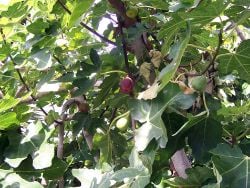 Common Fig foliage and fruit
| ||||||||||||||||
| Scientific classification | ||||||||||||||||
| ||||||||||||||||
| Ficus carica L. |
The Common Fig (Ficus carica) is a large, deciduous, shrub or small tree native to southwest Asia and the eastern Mediterranean region (Greece east to Afghanistan).
It grows to a height of 3-10 m tall, with smooth grey bark.
The leaves are 12-25 cm long and 10-18 cm across, and deeply lobed with three or five lobes.
The fruit is the well-known fig, 3-5 cm long, green ripening purple. The sap of the tree's green parts is an irritant to human skin.
The Common Fig is widely grown for its edible fruit throughout its natural range and also in the rest of the Mediterranean region and other areas of the world with a similar climate, including Australia, Chile, South Africa, and California, Oregon, Texas, and Washington in the United States.
The edible fig is one of the first plants that was cultivated by humans. An article in Science stated that nine fossilized figs dating to about 9400-9200 B.C.E. were found in the early Neolithic village Gilgal I in the Jordan Valley. As the figs were of the parthenocarpic type, they are of an early domestic breed. The find predates the domestication of wheat, barley and legumes, and may thus be the first known instance of agriculture.[1] Thousands of cultivars, most unnamed, have been developed or come into existence as human migration brought the fig to many places outside its natural range. It has bee\ \' ]\[ ]\[\[ ]\[]P ]P]n an important food crop for thousands of years, and was also thought to be highly beneficial in the diet.
Figs can be eaten fresh or dried, and used in jam-making. Most commercial production is in dried or otherwise processed forms, since the ripe fruit does not transport well, and once picked does not keep well. In Bengal, the fruit is called Dumur. It is cooked as a vegetable and is believed to be good for heart ailments.
Propagation : The flower is invisible, as it blooms inside the fruit. The small orifice visible on the middle fruit is a narrow passage, which allows a very specialised wasp, called Fig wasp) to enter the fruit & pollinate the flower, whereafter the fruit grows seeds.
FAO reports that Turkey was the top fig producer in 2005 followed by Egypt and other Mediterranean countries.
Historical significance
In June 2006, it was reported that figs dating back 11,400 years were discovered at Gilgal I, a village in the Lower Jordan Valley, just 8 miles north of ancient Jericho.[citation needed] There is evidence that figs were among the first cultivated crop, because they were of a mutation which could not reproduce normally. It is proposed that they may have been planted and cultivated intentionally, one thousand years before the next crops were domesticated (wheat and rye).
The phallic shape of the young fig is referred to in Song of Songs chapter 2 verse 13. The fig tree is sacred to Dionysus Sukites (Συκίτης).
Figs were also a common foodsource for the Romans. Cato the Elder, in his De Agri Cultura, lists several strains of figs grown at the time he wrote his handbook: the Mariscan, African, Herculanean, Saguntine, and the black Tellanian (De agri cultura, ch. 8).
Cultural & literary aspects
| Fig, dried, uncooked Nutritional value per 100 g | ||||||||||||||||||||||||||||||||||
|---|---|---|---|---|---|---|---|---|---|---|---|---|---|---|---|---|---|---|---|---|---|---|---|---|---|---|---|---|---|---|---|---|---|---|
| Energy 250 kcal 1040 kJ | ||||||||||||||||||||||||||||||||||
| ||||||||||||||||||||||||||||||||||
| Percentages are relative to US recommendations for adults. Source: USDA Nutrient database | ||||||||||||||||||||||||||||||||||
In the book of Genesis in the Bible, Adam and Eve clad themselves with fig leaves after eating the "Forbidden fruit" from the Tree of Knowledge of Good and Evil. Likewise, fig leaves, or depictions of fig leaves, have long been used to cover the genitals of nude figures in painting and sculpture. Often these fig leaves were added by art collectors or exhibitors long after the original work was completed. The use of the fig leaf as a protector of modesty or shield of some kind has entered the language.
The biblical quote "each man under his own vine and fig tree" (1 Kings 4:25) has been used to denote peace and prosperity. It was commonly quoted to refer to the life that would be led by settlers in the American West, and was used by Theodor Herzl in his depiction of the future Jewish Homeland[citation needed]. .Fig trees are also mentioned in Qur'an in many places.
Since the flower is invisible, there is a Bengali proverb : tumi jeno dumurer phool hoe gele = you have become (invisible like) the dumur flower. The derisive English idiom I don't care a fig probably originates from the abundance of this fruit.
In Greek mythology the god Apollo sends a crow to collect water from a stream for him. the crow sees a fig tree and waits for the figs to ripen, tempted by the fruit. He knows that he is late and that his tardiness will be punished so he gets a snake from the stream and collects the water. He presents Apollo with the water and uses the snake as an excuse. Apollo sees through the crow's lie and throws the crow, goblet, and snake into the sky where they supposedly make the constellations Hydra (constellation), Crater (constellation) and Corvus (constellation).
Figs and health
Figs are good source of flavonoids and polyphenols[2]. Figs and other dried fruit were measured for their antioxidant content. A 40 gram portion of dried figs (two medium size figs) produced significant increase in plasma antioxidant capacity [3]. Figs also have higher quantities of fiber than any other dried or fresh fruit, and are very high in calcium.
Picture gallery
- Tree leaf, Matson Photograph Collection, ca 1925-1946.jpg
Common Fig leaves and fruit
- Masaccio-TheExpulsionOfAdamAndEveFromEden-Restoration.jpg
The Expulsion from the Garden of Eden - fresco depicting a distressed Adam and Eve, with and without fig leaves, by Tommaso Masaccio, 1426-27
Notes and references
External link
External links
- Figweb Major reference site for the genus Ficus
- Video: Interaction of figs and fig wasps Multi-award-winning documentary
- Fruits of Warm Climates: Fig
- California Rare Fruit Growers: Fig Fruit Facts
- North American Fruit Explorers: Fig
- BBC: Fig fossil clue to early farming
ReferencesISBN links support NWE through referral fees
Credits
New World Encyclopedia writers and editors rewrote and completed the Wikipedia article in accordance with New World Encyclopedia standards. This article abides by terms of the Creative Commons CC-by-sa 3.0 License (CC-by-sa), which may be used and disseminated with proper attribution. Credit is due under the terms of this license that can reference both the New World Encyclopedia contributors and the selfless volunteer contributors of the Wikimedia Foundation. To cite this article click here for a list of acceptable citing formats.The history of earlier contributions by wikipedians is accessible to researchers here:
The history of this article since it was imported to New World Encyclopedia:
Note: Some restrictions may apply to use of individual images which are separately licensed.
